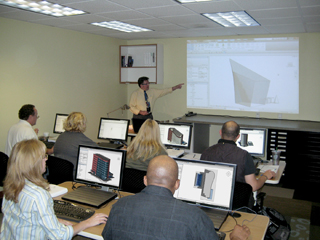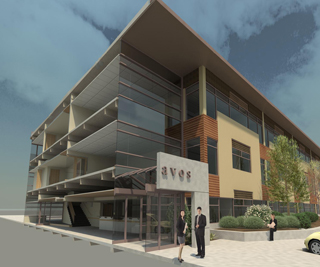|
Subscribe / Renew |
|
|
Contact Us |
|
| ► Subscribe to our Free Weekly Newsletter | |
| home | Welcome, sign in or click here to subscribe. | login |
Architecture & Engineering
| |
 |
October 28, 2010
Using technology as a springboard to new work
Special to the Journal

Baker
|
New business development during an economic downturn takes on a whole new meaning when your firm is suddenly faced with triple the competition on each new project seeking architectural services.
No longer can you rely solely on a great track record, a particular niche, or even traditional networking to find or win one of the few projects reaching the proposal phase. These new conditions led Seattle’s DKA Architecture to forge a new path, one that uses technology as a springboard to new opportunities and increased revenues.
The cornerstone of this new approach is the firm’s growing expertise in Autodesk’s Revit, a building information modeling software that was introduced about a decade ago. The software allows contractors, architects, owners, subcontractors and others to build projects virtually in 3-D, saving money and time in the process. Building virtually is the future of development, and was first embraced by general contractors.
According to a recent Forbes article on virtual construction, industry use of BIM tools went from 28 percent of firms to 48 percent between 2007 and 2009. BIM is fueling growth in Autodesk’s 3-D modeling business, which grew 10 percent last year, according to the article. Architects have been slow to adopt the evolving technology, but it’s a collaborative concept that’s gaining steam.
Most firms simply learn the software and add it to their toolbox. DKA, however, is using its Revit expertise to foster new partnerships, to teach others how to use the software, and to market to a new group of clients: building owners and their facilities managers.
DKA first adopted Revit two years ago, and, like many firms, had questions that software resellers and their trainers couldn’t answer, largely because trainers lack knowledge of the design and construction process. While the software trainers could answer technical questions regarding the software’s cool clicks and picks, they couldn’t explain how one could leverage the technology when talking to contractors in the field.
“We had a lot of questions and found it a struggle to get the answers we needed,” says Rico Quirindongo, a partner at DKA. “We realized we needed to figure out how to do many things ourselves and also realized we could help others asking the same questions.”
Those seeking training are typically smaller architecture firms without a large budget for training, individuals seeking to upgrade their skills, and larger firms that find outside training more cost-effective than setting up a training department in-house.
DKA began offering certified Revit classes earlier this year and has since trained more than 30 people through a new service division. That has allowed DKA to get to know other architects and firms, exposure that may lead to collaboration or project referrals, Quirindongo said.
The potential market for training is rather large when one takes into account the collaborative nature of building virtual buildings, which is a major benefit of the 3-D technology.
“No longer are we drawing lines on a page but we’re literally picking a wall type, specifying its thickness and its makeup and laying that wall down in a virtual environment,” Quirindongo says. “We’re telling the software how long and high the wall is and then cutting holes in the wall for windows. This saves a lot of time because instead of lines and elevations that have to be coordinated manually, you erect the building model in a virtual environment and simply generate different views.”
The 3-D model incorporates heating, electrical and plumbing runs, among other building aspects, allowing all team members to see where there might be potential problems before pouring the foundation. Traditionally, such problems might only be noticed midway through construction, causing delays and cost overruns. It also brings the entire construction crew — including subcontractors — into the project prior to breaking ground, which is much earlier than building traditionally.
This means small engineering firms, utility companies, HVAC firms, electricians and plumbers, among others, need to understand how to use and read BIM and 3-D modeling systems, Quirindongo says.
“We’re reaching out beyond architects to small general contractors and small engineering firms to engage them in the process,” he says. “When you get those collateral trades in the room what always comes out are conversations that often led to opportunities, to job prospects, to teaming and often can lead to new jobs.”
The software expertise is also allowing them to reach out to a new market: building owners.
“Since we’re using Revit across many disciplines, we end up building integrated teams with contractors early on,” Quirindongo says. “The model inherently becomes not only a design but a coordination tool that saves time because you’re no longer trying to make plans to match elevations and sections.”
For instance, door installation schedules that were once done manually and laboriously created and recreated, can be automatically populated into a master schedule that also generates project specifications. Once BIM models are created, they can be used by building owners for facilities maintenance and operations.
“That means when a guy on the fifth floor of a seven-story building springs a leak in his kitchen, no one has to start randomly breaking walls to find the right plumbing run,” Quirindongo says. “When you build virtually in 3-D, you can see exactly where the problems might be and how to get to the right pipes.”
DKA hopes to assist a major university’s facilities department recreate its campus in 3-D. By training the university’s staff how to use the software, they will be able to build a dynamic database of information that they can leverage to manage their facilities more efficiently, even as they continue to grow the data.
Quirindongo, who attended a meet-and-greet presentation with a local port authority recently, used the opportunity to ask port management whether they were aware of 3-D modeling capabilities, a conversation that has sparked interest in DKA’s services and expertise.
The potential revenues from training services and indirect opportunities are hard to measure at this early stage for DKA, Quirindongo says. But the potential is large even on a regional scale when one realizes the once-futuristic idea of truly integrated building teams — owners, architects, contractors, engineers and trades — working together to design a building before the first spade of dirt is turned.
“There are a few large firms out there nationally that have started to try to make true integrated project delivery teams work, but there is no real business model yet for smaller practices,” Quirindongo says. “We all know conceptually that getting the best out of each member of the team at the beginning guarantees far better results, and almost always guarantees that you’ll get solutions faster, you’ll save time and save money.”
M. Sharon Baker is a freelance journalist who specializes in writing contributed articles, case studies and other marketing, web and public relations materials for corporate clients. DKA Architecture is one of her many clients.
Other Stories:
- Buck the recession with strategies for success
- Architectural viability can enhance mixed-use projects
- Creating successful projects in a difficult market
- Play ‘matchmaker’ with your staff to get work
- What your HVAC techs aren’t telling you
- What the U.S. and China can learn from one another
- Why A/E firms should care about social media
- Data center design focuses on five fundamentals
- What PGE learned while removing Marmot Dam
- Have you secured your firm's value?
- Swedish’s Issaquah project taps into energy rebates




